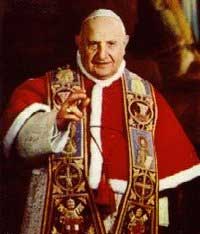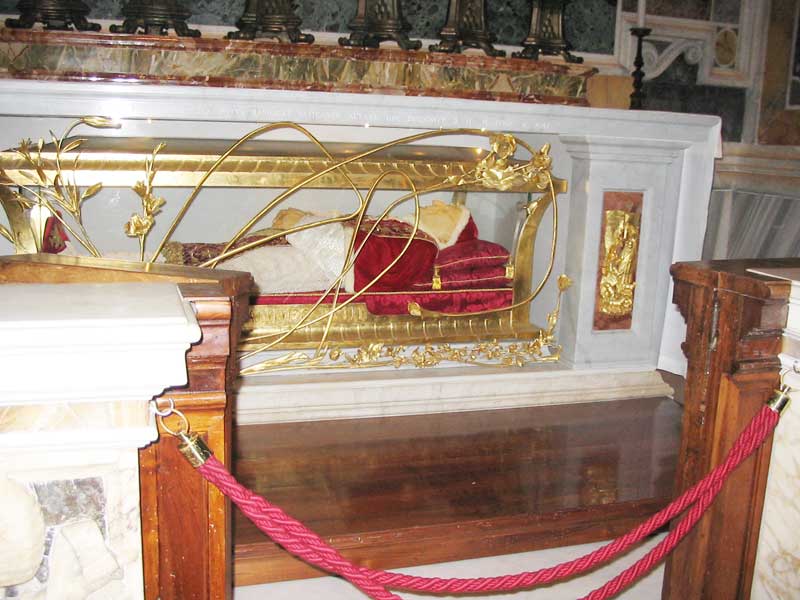

Pope John XXIII (Latin: Ioannes PP. XXIII), born Angelo
Giuseppe Roncalli (November 25, 1881 – June 3, 1963), reigned as the 261st
Pope of the Catholic Church and sovereign of Vatican City from October 28,
1958 until his death in 1963.
Earlier life
Angelo Roncalli was born in a hospital (Province of Bergamo), Italy, on
November 25, 1881. The fourth in a family of 13, his family worked as
sharecroppers, a striking contrast to his predecessor, Eugenio Pacelli, who
came from an ancient aristocratic family, long connected to the Papacy.
In 1904, Roncalli was ordained a priest in the Roman Church of Santa Maria
in Monte Santo. Ten years later, during World War I, he was drafted into the
Royal Italian Army as a sergeant, serving in the medical corps and as a
chaplain.
In 1921, Pope Benedict XV appointed him as the Italian president of the
Society for the Propagation of the Faith. In 1925 Pope Pius XI appointed him
as Apostolic Visitor to Bulgaria, also naming him for consecration as
titular bishop of Areopolis. He chose as his episcopal motto Obedientia et
Pax ("Obedience and Peace"), which became his guiding motto.
In 1935 he was made Apostolic Delegate to Turkey and Greece. Roncalli used
this office to help the Jewish underground in saving thousands of refugees
in Europe, leading some to consider him to be a Righteous Gentile. In 1944,
during World War II, Pope Pius XII named him Apostolic Nuncio to Paris,
France.
In 1953, he was named the Patriarch of Venice, and, accordingly, raised to
the rank of cardinal. As a sign of his esteem, President Vincent Auriol of
France claimed the ancient privilege possessed by French monarchs and
bestowed the red hat on the now-Cardinal Roncalli at a ceremony in the
Elysee Palace. Of his time in France, John later related in a humorous
account that, when a woman wearing a daringly low-cut dress arrived at a
reception which he was attending, the people assembled in the room did not
watch the woman, but, rather, him to see if he was watching the woman.
Papacy
Following the death of Pope Pius XII in 1958, Roncalli was, to his own great
surprise, elected Pope. For the longest time, Archbishop Montini, Archbishop
of Milan, was the leading candidate. Though he was named to head one of the
most ancient and prominent archdioceses in Italy, Pius had refused to name
Montini a cardinal (or, according to some accounts, Montini had refused the
honor). As a result, Montini, who would later become Pope Paul VI, was shut
out of the following election, and most of the cardinals in the conclave
considered him not to be available—in spite of canon law that said any
Catholic male could be chosen. After the long pontificate of John's
patrician predecessor, the cardinals chose a man whom they presumed, because
of his advanced age and personal modesty, would be a short-term or
"stop-gap" pope. The cardinals reasoned that by the time this "stop-gap"
pope died, Montini would probably have been raised to the Cardinalate, and
would be available for election. In fact, one of Roncalli's first acts as
Pope was to raise Montini to that rank.
What the cardinals and the rest of the Church did not expect was that Pope
John's personal warmth, good humour and kindness would capture the world's
affections in a way his predecessor, for all his great learning and personal
holiness, had failed to do. While Pius would look slightly away and up from
the camera whenever his photograph was taken, John would look directly at
the camera and smile. He undertook the first official act of a Pope away
from Vatican territory since 1870 when he visited prisoners, telling them,
"You could not come to me, so I came to you." When the First Lady of the
United States, Jacqueline Kennedy, arrived in the Vatican to see him, he
nervously rehearsed the two methods of address he had been advised to use
when she entered: "Mrs. Kennedy, Madame" or "Madame, Mrs. Kennedy". When she
did arrive, however, to the amusement of the press corps, he abandoned both
and rushed to her saying, "Jackie!"
Nor did Pope John's radicalism stop at his informality. To the astonishment
and horror of aides, he called an ecumenical council less than ninety years
after the controversial Vatican Council. While his aides talked of spending
a decade in preparation, John planned to hold it in a matter of months. From
the Second Vatican Council, or Vatican II, came changes that reshaped the
face of Catholicism: a new Mass (liturgy), a new ecumenism and a new
approach to the world.
He met the Most Rev. Geoffrey Francis Fisher, the Archbishop of Canterbury,
for about an hour in the Vatican on December 2, 1960. It was the first time
in over 400 years, since the excommunication of Elizabeth I, that the
Archbishop of Canterbury had met with the Pope.
Pope John XXIII excommunicated Fidel Castro on January 3, 1962 in line with
a 1949 decree by Pope Pius XII forbidding Catholics from supporting
communist governments.
Pope John XXIII died of stomach cancer on June 3 1963, at the age of 81. On
December 6, 1963 President Lyndon B. Johnson posthumously awarded him the
Presidential Medal of Freedom, the United States' highest civilian award, in
recognition of the good relationship between Pope John and the United States
of America.
Legacy
Known affectionately as "Good Pope John" and "the most loved Pope in
history" to many people, in 2000 John was declared "Blessed" by Pope John
Paul II, the next-to-last step on the road to sainthood. Following his
beatification, his body was moved from its original burial place in the
grottoes below St Peter's Basilica to near the main altar, and displayed for
the veneration of the faithful.
At the time, the body was observed to be extremely well-preserved—a
condition which the Church ascribes to the lack of oxygen in his sealed
triple coffin rather than to any miraculous event (although it was certainly
seen as such by many of the faithful). When John was moved, the original
vault - which was above the floor - was removed. A new vault was built
beneath the ground, and Pope John Paul II was later buried in this vault.
He is also honored by many Protestant organizations as a Christian reformer.
Both Anglican and Lutheran denominations commemorate John XXIII as a
"renewer of the church."
From his early teens, Blessed Pope John maintained a diary of spiritual
reflections that was subsequently published as Journal of a Soul. The
collection of writings charts Roncalli's efforts as a young man to "grow in
holiness" and continue after his election to the Papacy. it remains a
religious classic.
Modern conspiracy theories
John XXIII's embalmed body being taken to its new resting place in St
Peter's Basillica.A fringe of conservative Catholics—those who disagree with
Vatican II—have derided Pope John's influence in calling the council, seeing
in him the beginnings of a movement away from the "true faith".
According to one theory, Pope John was actually an antipope, and the real
pope was Giuseppe Cardinal Siri, elected in the 1958 conclave when what may
have been white smoke was first seen.
The United States Federal Bureau of Investigation (FBI) allegedly claimed
that Siri had indeed been elected on the third ballot of the 1958 papal
conclave.[1] What is unambiguously known is that Vatican Radio did conclude,
on the basis of apparently white smoke, that a pope had been elected on the
third ballot and announced it as such, telling listeners "The smoke is
white. . . . There is absolutely no doubt. A pope has been elected."[2] An
FBI source also claimed that Siri was elected a second time on the third
ballot.[3] After the 6pm 3rd ballot white smoke appeared, not only the
public was confused. The Swiss Guards assembled to give the ceremonial
salute to the new pontiff, only to have to withdraw again.
The white smoke often had proven a confusing symbol in the past, leading
John Paul II to decree the use of ringing bells in addition to the smoke
after a papal election. Allegedly, Siri had even chosen a name, "Gregory
XVII", and was preparing to appear at the balcony, but was threatened
somehow and forced aside, leaving the cardinals free to elect Roncalli as
Pope. Supporters of this theory maintained that Siri was informed that his
election would lead to anti-Catholic pogroms in the Eastern Bloc. They claim
that rather than endanger the lives of Catholics in the Union of Soviet
Socialist Republics and elsewhere, Siri announced non accepto (I do not
accept the papacy.) According to the proponents of this theory, Siri was
still validly pope, and as such had the papal graces and protection of the
Holy Ghost from error, and John thus did not, leading to his calling of the
modernizing Second Vatican Council. Such speculations can neither be proved
or disproved, as papal conclaves are held under the strictest secrecy, with
violations punishable by excommunication. Siri made no effort either to
confirm or deny the claim that he had been elected pope, insisting simply in
a 1986 interview "I am bound by the secret. This secret is horrible. I would
have books to write about the different conclaves. Very serious things have
taken place. But I can say nothing."[4] However he discouraged Sedevacantism
and openly accepted John XXIII and his successors as the legitimate popes.
Some also make unsubstantiated claims that John was a Freemason, and as
such, allegedly could not be a valid Pope since Catholics were forbidden at
that time from joining Freemasonry under pain of excommunication. Some also
make the claim that John's choice of regnal name marked him as an antipope,
as the name John had lain unused since Antipope John XXIII used it in the
14th century (this can easily be shown to be false, as many antipopes had
chosen traditional regnal names which were later used by legitimate Popes,
including two Benedicts XIV).
Many who subscribe to the teachings of Our Lady of Fatima also believe that
Pope John deliberately withheld secret prophetic information revealed by an
apparition of the Virgin Mary. [5] This is perhaps the basis for internet
reports in the late 1990s about the supposed discovery of Pope John's diary
where he received prophetic insight into the future, including the return of
Jesus in New York in 2000. [6] Although Pope John did have a diary there is
no evidence in it to suggest that he received apocalyptic visions of the
future. [7]
Footnotes
1 Department of State secret dispatch, "John XXIII," issue date:
November 20, 1958, declassified: November 11, Paul L. Williams, The Vatican
Exposed (Amherst, NY: Prometheus Books, 2003), pp. 90-92.
2 The Tablet, November 1, 1958
3 Department of State secret file, "Cardinal Siri," issue date: April 10,
1961, declassified: February 28, 1994, William, Op. Cit pp.90-92.
4 Louis Hubert Remy, "The Pope: Could He Be Cardinal Siri?" (1986)
translated into English by Heidi Hagen for “The Sangre de Cristo Newsnotes”
- No. 55 - December 1987. For the controversy concerning Siri's alleged
election in the 1958 and 1963 conclaves, see Malachi Martin, The Keys of
this Blood (New York, NY: Touchstone, 1991) pp. 607-608 |

